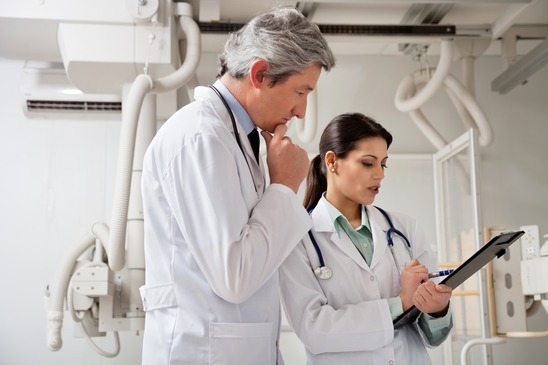Educate fluoroscope operators
Anyone operating a fluoroscope should be trained in basic fluoroscopy physics, basic radiation biology, and radiation safety. The Basic Training Program from FluoroSafety provides this necessary didactic training for practitioners who perform simple fluoroscopic procedures, and for personnel, including nurses, anesthesia support, and others, who work in a fluoroscopy lab.
Practitioners who frequently perform fluoroscopic procedures or who perform fluoroscopically-guided interventions require training in some additional areas, including advanced fluoroscopy physics, dose monitoring, and optimizing patient dose. The Advanced Training Program from FluoroSafety provides this training.
Situational awareness
A phrase most often heard on sports broadcasts, situational awareness is critical during fluoroscopic procedures. Everyone involved in a fluoroscopic procedure should be aware of potentially dangerous situations, and a culture of respect and safety must be in place so anyone feels comfortable speaking up when they see a potentially dangerous situation. For example, during fluoroscopic procedures performed with a mobile C-arm in the operating theatre, a patient’s arm may be placed dangerously close to the output port of the X-ray tube, especially if the spacer cone has been removed. The physician is often concentrating on the medical aspects of the procedure, and may not notice that the patient is in danger. However, a technologist or nurse may notice, and they should immediately notify the physician that the procedural setup requires modification.
Dose monitoring and audits
Every practice using fluoroscopy should be recording dose metrics from procedures and should have a process in place to review these metrics on a regular basis. Dose metrics can be compared to national averages or other published data to identify targets for practice quality improvement. Consider the data in the table below. When performing nephrostomy placements, Facility A has reference air kerma values (Ka,r) that are similar to published national averages. However, Facility A has air kerma area product (PKA) values that are substantially higher than the national average. This could indicate that Facility A needs to pay more attention to collimation of the X-ray beam during fluoroscopic procedures.
Metric Facility A National Average
Reference air kerma (Ka,r) 250 mGy 245 mGy
Air kerma area product (PKA) 90 Gy-cm² 49 Gy-cm²
Consent
Practices performing complex fluoroscopically-guided interventions should add a few more elements to their patient safety programs. These elements and others are discussed in more detail in the Establishing a Patient Safety Program course from FluoroSafety.
Patients who are considering undergoing a potentially high dose fluoroscopic procedure should be explicitly informed of the risk, albeit very small, of a radiation-induced skin reaction. This is both ethically responsible and documents that the practice informed the patient that a skin reaction was a potential risk.
Notification levels
Notification levels can be considered a particular form of situation awareness. A notification level is a Ka,r threshold that, when reached, triggers specific actions by the practitioner. Most importantly, a notification level is an opportunity for the operator to consider the risk/benefit pace of the procedure and to make modifications to the procedure that reduce the rate at which skin dose accumulates. The table below is an example of notification levels for vascular and interventional radiology procedures.
| Ka,r Notification Level (mGy) | Suggested Action |
|---|---|
| 2,500 | Verify Good Practice is being used |
| 5,000 | Substantial radiation dose level. Flag patient for follow up. Measure and record patient table height. |
| 7,500 | Verify Good Practice. Re-evaluate risk/benefit pace of procedure, entering range of potential skin injury. |
| 10,000 | Verify Good Practice. Re-evaluate risk/benefit pace of procedure. Skin injury more likely. |
Follow up of patients experiencing high skin doses
A follow-up protocol should be in place for patients experiencing doses greater than a practice’s Substantial Radiation Dose Level (SRDL). The National Council on Radiation Protection and Measurement recommends that the SRDL for Ka,r be set at 5 Gy (5,000 mGy). The follow-up protocol may include a 4-week phone or in-person follow-up, and a procedure for intensive management of patients suspected to have a skin reaction. A procedure for tracking patients undergoing multiple or repeated high dose procedures should also be in place
About The Author:
A. Kyle Jones, PhD, DABR
Co-Founder, Fluoroscopic Safety, LLC
Dr. Kyle Jones earned his B.S. in physics from Furman University and his M.S. and Ph.D. in medical physics from the University of Florida. Dr. Jones is currently employed as a Diagnostic Medical Physicist and Assistant Professor at MD Anderson Cancer Center.
Dr. Jones is board certified in Diagnostic Medical Physics by the American Board of Radiology, is a Licensed Medical Physicist in the state of Texas, and is MQSA qualified. Dr. Jones is active in multiple research endeavors in the fields of radiation safety and diagnostic medical physics, is widely published in high impact journals, and is actively involved in teaching and training medical physics graduate students, medical physics residents, and interventional radiology fellows.


Leave a Reply